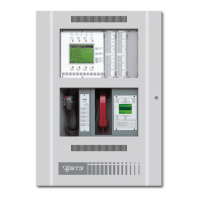Access control applications
EST3 Installation and Service Manual 3.11
Anti-passback
Description of the application
Anti-passback is a feature of the access control system that
prevents successive use of one card to pass through any door in
the same direction. Anti-passback prevents a card from being
passed back to another person for the purpose of gaining
unauthorized access.
The CRC supports three forms of anti-passback:
• Strict
• Logged
• Timed
Strict anti-passback is the most restrictive form of anti-passback.
It requires all personnel to badge in and out, denying them access
to an area when they fail to do so.
Logged anti-passback is less restrictive than strict anti-passback.
It still requires personnel to badge in and out but does not deny
access when anti-passback rules are violated. Rather, such access
is logged as an access granted anti-passback event. With logged
anti-passback, security staff can work to correct violations, but
personnel are not locked out.
Timed anti-passback prevents reuse of a card for a specific
period, but does not require personnel to badge out. A timed
anti-passback system automatically badges a cardholder out of
the controlled partition after a specified time period, allowing the
card to be used again.
Note: Timed anti-passback cannot be used with a muster
application, since the system automatically logs cardholders out
of the partition, defeating muster accounting.
To implement anti-passback, a separate CRC is required at each
doorway in the controlled partition. Each doorway requires an
outside card reader. Strict and logged anti-passback applications
also require an inside reader at every doorway. Timed anti-
passback does not require the use of an inside card reader.
A typical anti-passback application is shown in Figure 3-2,
below.
The figure shows a building with a perimeter fence. It would be
easy for an employee to pass his access card to an unauthorized
individual through the fence, thereby allowing access.
Configuring the access control system for anti-passback
operation can help prevent this from happening.

